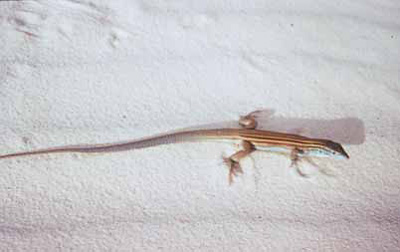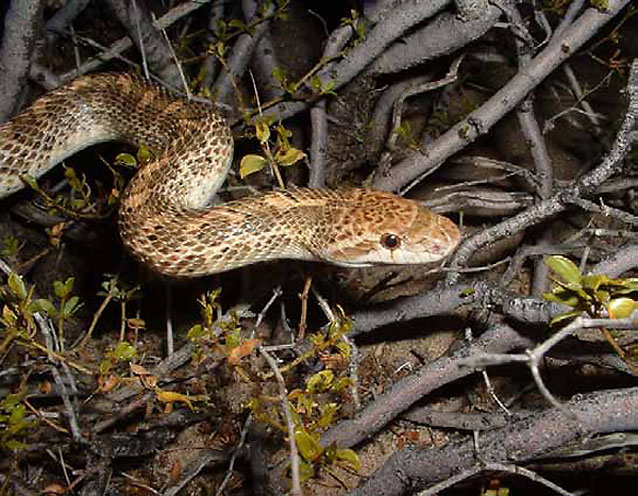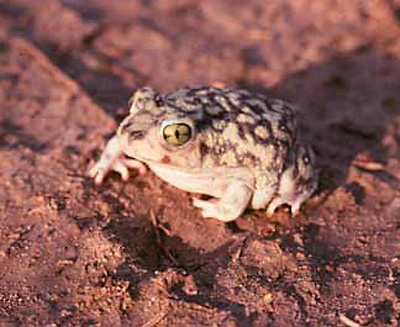White Sands National Monument (NM) is located in south central New Mexico in the Tularosa Basin of the Chihuahuan Desert and is part of the largest white gypsum dune field in the world.

NPS
While most of the park consists of gypsum sand dunes, there is an area of desert scrub and a large playa present on the western side of the park. Reaching this habitat required driving across the White Sands Missile Range where associated regulatory requirements impacted the survey effort. The inventory took place from May to September 2003 and only 15 person-days of data are available for 2004 due to limited staff availability and loss of data.
Methods
Several search approaches were implemented to find reptiles and amphibians: foot surveys, incidental observations, pitfall traps, and road cruising. Different approaches were used each year (2003 and 2004) to maximize the likelihood of finding different species. For each reptile or amphibian observed, location, time, weather, and species were recorded.

James Borgmeyer
Foot surveys were conducted at times when reptiles and amphibians were most likely to be active (morning around sunrise and evening around sunset). Most of the foot surveys were conducted off-trail. While on foot, searches included looking under rocks and logs, and mirrors and flashlights were used to illuminate crevices. Incidental observations were recorded while the researchers were not conducting formal searches (e.g., on days off or while driving to a search area).
Pitfall traps were used to capture small reptiles and amphibians running or crawling across the ground. In 2003, two sets of pitfall and funnel traps were checked by park staff and volunteers daily (138 times). The traps in White Sands NM were dismantled after the project. Road cruising surveys were conducted at night to find amphibians and nocturnal snakes and lizards.
Voucher specimens were collected for nearly each species found in the park. Voucher specimens provide proof that the species actually occurred in the park during the inventory and help to confirm it was correctly identified in the field. These specimens provide important data about reproduction, diet, health, and morphology. DNA collected from voucher specimens can be used to examine population questions and genetic relationships within and between species. For this inventory, the voucher specimens from White Sands NM are on permanent loan to and stored at the Museum of Southwestern Biology, University of New Mexico, Albuquerque, and are freely available to researchers and managers.
Results
In total, 810 reptiles and amphibians were found at White Sands NM, representing 28 species: six toads, 10 lizards, 11 snakes, and one turtle. The majority of observations were recorded during foot surveys: 360 animals of 22 species. Incidental observations accounted for 230 animals of 26 species and 219 animals of 16 species were caught in pitfall traps. Only one individual was detected during road cruising surveys. A total of 29 voucher specimens comprising 27 species were collected. No state or federally listed or non-native species were found during this inventory.
Discussion

NPS
In order to determine what percentage of the actual total herpetofauna community was documented in this inventory, the results were compared to existing lists of reptile and amphibian species likely to occur in the monument. It is estimated that there are 10 species that are likely to occur in White Sands NM that were not observed (one salamander, four lizards, and five snakes), meaning this inventory may have documented 74% of the reptile and amphibian species in the park.
This inventory can be used as baseline data for future monitoring. Long-term monitoring and/or repeated inventories may help detect changes within reptile and amphibian communities caused by climate change, drought, invasion by non-native species, wildland fire, or other factors. Reptile and amphibian populations can change dramatically between surveys in a given year due to the timing and amounts of precipitation. Future monitoring or inventories should survey each area multiple times in a season.
Part of a series of articles titled Chihuahuan Desert Network Reptile and Amphibian Inventories.
Last updated: January 5, 2017
